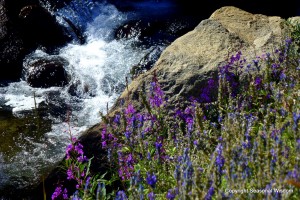
Spanning 150 miles through California, the Eastern Sierras are home to many wonderful wildflowers – including these blue lupines and magenta fireweeds growing alongside Rock Creek in the Little Lakes Valley.
This old glacial cirque is a mountain valley filled with picturesque lakes and flower-filled meadows. The area offers a colorful collection of subalpine and alpine wildflowers, especially on wet years. Come along with Seasonal Wisdom, as we explore a few wildflowers of the Eastern Sierras.
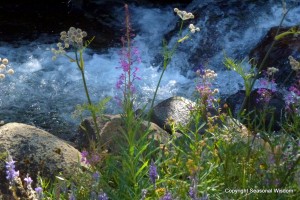 You can hike, fish, camp and backpack in the Eastern Sierras of California. But one of my favorite things to do in this idyllic, high-altitude area is to spot the wildflowers on our summer mountain hikes.
You can hike, fish, camp and backpack in the Eastern Sierras of California. But one of my favorite things to do in this idyllic, high-altitude area is to spot the wildflowers on our summer mountain hikes.
One of the prettiest places to hike is Little Lakes Valley, near Tom’s Place in the Eastern Sierras. This post includes some wildflower photos from August hikes in 2009 and 2013.
Above, white ranger buttons (Spenosciadium capitellatum), magenta fireweed (Epilobium angustifolium) and blue lupine (Lupinus) grow alongside Rock Creek in 2013. Click on photos to make larger images.
This photo was taken not far from the Mosquito Flats trailhead (elevation 10,200 feet), the highest trailhead in the Sierras. As a comparison, the highest mountain in the Northeastern U.S. is New Hampshire’s Mount Washington, which peaks at 6,289 feet.
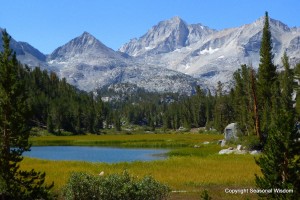 Mosquito Flats trailhead leads into Little Lakes Valley, where snow melt has formed a number of picturesque, high altitude lakes.
Mosquito Flats trailhead leads into Little Lakes Valley, where snow melt has formed a number of picturesque, high altitude lakes.
An example is Marsh Lake, which has plenty of large brown trout for anglers. This was the location of a rather idyllic picnic lunch for us in August 2013. However, the lake is smaller than I remember it from 2009.
The Little Lakes Valley trail is gradual, making it a delightful day trip. But the high altitude means this is a moderate hike. Acclimatization to altitude is definitely recommended, especially for beginners.
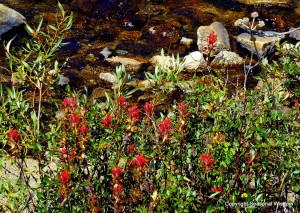 Various types of paintbrush (Castilleja) can be found growing throughout the area, in grassy fields and along the bubbling creek. This flower actually looks a bit like a paintbrush, making it easier to spot.
Various types of paintbrush (Castilleja) can be found growing throughout the area, in grassy fields and along the bubbling creek. This flower actually looks a bit like a paintbrush, making it easier to spot.
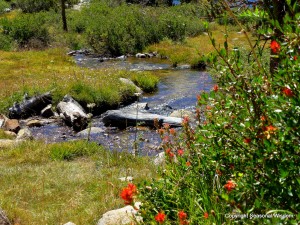 Here are more paintbrush flowers growing in the mountain meadow, along Ruby Creek.
Here are more paintbrush flowers growing in the mountain meadow, along Ruby Creek.
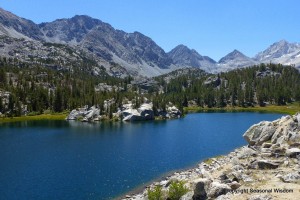 Our destination on this August 2013 hike was Chicken Foot Lake (10,761 feet elevation), where the clear blue lake was surrounded by majestic mountains. It’s a couple miles of relatively easy climbing, each way, but the high altitude packs a punch if you’re not used to it. Consider yourself warned.
Our destination on this August 2013 hike was Chicken Foot Lake (10,761 feet elevation), where the clear blue lake was surrounded by majestic mountains. It’s a couple miles of relatively easy climbing, each way, but the high altitude packs a punch if you’re not used to it. Consider yourself warned.
This was our turn-around point, but you can journey on to Gem lakes or Morgan Pass (11,000+ feet elevation).
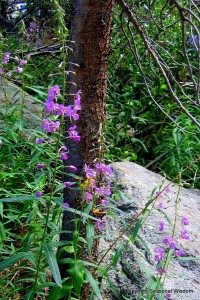 Fireweed grows from 2 to 7 feet tall, and can be found throughout the Little Lakes Valley area. This particular plant was about 5 feet tall in this semi-shady spot near water in 2009.
Fireweed grows from 2 to 7 feet tall, and can be found throughout the Little Lakes Valley area. This particular plant was about 5 feet tall in this semi-shady spot near water in 2009.
Not surprisingly, this wildflower thrives in areas burnt by fire, which gives the flower its name.
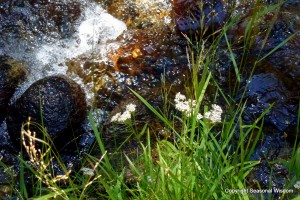 Wild, white yarrow (Achillea) dots meadows and stream banks. Look carefully and you’ll see yarrow in this photo taken in 2013 not far from our campsite, which backed up to this creek.
Wild, white yarrow (Achillea) dots meadows and stream banks. Look carefully and you’ll see yarrow in this photo taken in 2013 not far from our campsite, which backed up to this creek.
Incidentally, yarrow has been popular for centuries with native tribes, carpenters and soldiers, as the medicinal herb helps stop bleeding and aid healing.
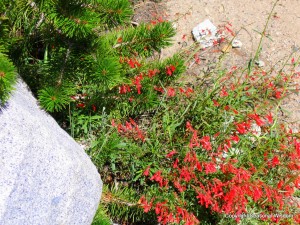 Red fuchsia (Zauschneria californica) has tubular-shaped flowers that are popular with hummingbirds. The drought-tolerant wildflower grows about a foot high, and was spotted on our hike in 2009.
Red fuchsia (Zauschneria californica) has tubular-shaped flowers that are popular with hummingbirds. The drought-tolerant wildflower grows about a foot high, and was spotted on our hike in 2009.
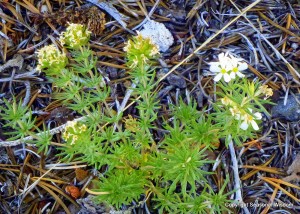 A spreading phlox was seen along a dusty mountain trail in 2013. Typically, the low-growing wildflower is covered with little white flowers, but it’s been a dry year in the Sierras.
A spreading phlox was seen along a dusty mountain trail in 2013. Typically, the low-growing wildflower is covered with little white flowers, but it’s been a dry year in the Sierras.
In fact, the Sierra Nevada has experienced two years of drought. You can see the impact of these dry years on this mountainous area from the next two photos.
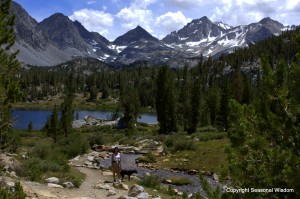 This photo of Heart Lake and Ruby Creek in Little Lakes Valley was taken in August 2009. You can see how lush and green the alpine meadows looked that summer. There was still snow on parts of the mountains.
This photo of Heart Lake and Ruby Creek in Little Lakes Valley was taken in August 2009. You can see how lush and green the alpine meadows looked that summer. There was still snow on parts of the mountains.
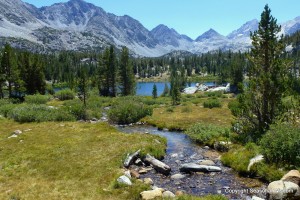 Now look at Heart Lake and Ruby Creek in August 2013. It’s still beautiful, but not as green, and there is less snow on the mountains.
Now look at Heart Lake and Ruby Creek in August 2013. It’s still beautiful, but not as green, and there is less snow on the mountains.
Near the lakes and creeks, there are plenty of wildflowers growing. However, as you get further away from the water, it’s easier to see how the recent drought has affected this area’s vegetation.
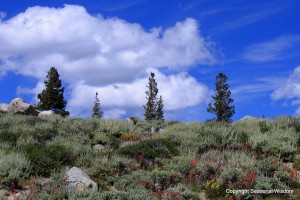 It’s all about the water, when it comes to the wildflowers of the Eastern Sierras.
It’s all about the water, when it comes to the wildflowers of the Eastern Sierras.
That was certainly the case in 2009. Just look at the rolling hills around Rock Creek Lake, lush with white sage, red paintbrush and yellow sulphur flowers (also known as buckwheat).
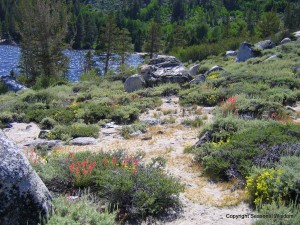 I was so charmed by the wildflowers in 2009 I took these photos with the hopes of writing a blog post. Life got in the way, so the post was never written.
I was so charmed by the wildflowers in 2009 I took these photos with the hopes of writing a blog post. Life got in the way, so the post was never written.
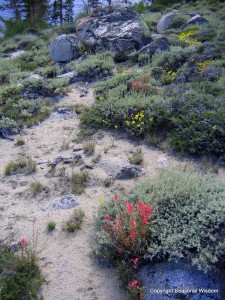 But now these photos are a vivid reminder of how this mountain area can look when it receives a normal amount of snowfall and rain.
But now these photos are a vivid reminder of how this mountain area can look when it receives a normal amount of snowfall and rain.
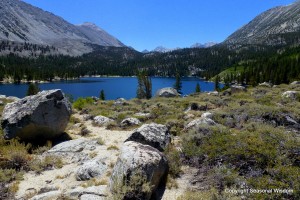 Here are those same hills above Rock Creek Lake four years later, facing the other direction towards the lake. In August 2013, only the most drought tolerant wildflowers were spotted here.
Here are those same hills above Rock Creek Lake four years later, facing the other direction towards the lake. In August 2013, only the most drought tolerant wildflowers were spotted here.
 But even in drought conditions, these burnt orange sulphur flowers kept growing on this dry Eastern Sierra hillside. They are a good reminder of how Mother Nature overcomes obstacles and finds ways to survive in less than ideal situations.
But even in drought conditions, these burnt orange sulphur flowers kept growing on this dry Eastern Sierra hillside. They are a good reminder of how Mother Nature overcomes obstacles and finds ways to survive in less than ideal situations.
Wildfires Make Wildflowers
As I write this blog post, a gigantic wildfire has been burning in and around Yosemite National Park, just hours from Little Lakes Valley.
On Sept. 2, 2013, the “Rim Fire” was more than 351 square miles – an area larger than the cities of San Francisco, San Jose and Oakland combined – making it California’s fourth-largest fire in history.
It breaks my heart to think of mountain trees and meadows burning. But, Mother Nature seems to require wildfires to sustain the wildflower population.
Ironically, many wildflowers lie dormant for decades, only to germinate like crazy after a fire. Other wildflowers can’t germinate without fires, while the burned remains of shrubs can greatly stimulate other wildflower seeds into growing. These flowers actually thrive in the ash left behind from these fires. How wildfires make wildflowers.
That being said, we have our fingers crossed for a heavy snowfall this winter in the Eastern Sierras. Let’s hope the mountains have plenty of water – and wildflowers – next August.
- Take only photos, but leave only footprints (no trash) in this pristine natural area.
- Bring your own water to the trailhead.
- This is bear country. For your own safety – and to keep bears from getting shot – please dispose of trash in proper bear-proof canisters. Do not leave any food, makeup or body crèmes in your car.
Find Your Own Wildflowers
Hot Spots for Wildflowers of the Eastern Sierras
Photos of Wildflowers of the Eastern Sierras
Rock Creek Trail to Little Lakes Valley
Take Virtual Hike of Little Lakes Valley
How Wildfires Make Wildflowers
On the Other Coast: Native Plants of North Carolina
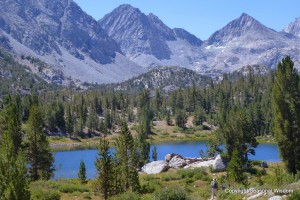











{ 2 comments }
I miss the wild flowers of California. When the High Desert blooms it is miles of color where sand used to be…
Wow, Tim. That sounds amazing. Aren’t wildflowers and native plants wonderful? Thanks for visiting. Teresa
Comments on this entry are closed.
{ 2 trackbacks }